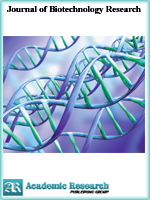Journal of Biotechnology Research
Online ISSN: 2413-3256
Print ISSN: 2413-8878
Print ISSN: 2413-8878
Quarterly Published (4 Issues Per Year)

Archives
Volume 5 Number 9 September 2019
Removal of Heavy Metal of Copper Using Microbial Nano Cellulose from Industrial and Hospital Wastewater
Authors: Ali Ashjaran ; Pegah Zare
Pages: 85-92
DOI: doi.org/10.32861/jbr.59.85.92
Abstract
Industrial and municipal wastewater typically contains metal ions. When these metal ions are more than allowed, they can be harmful to aquatic organisms and human health. Environmental pollution by heavy metals is one of the main environmental problems. In this study, microbial nano cellulose was used as adsorbents in removing copper from wastewater. The purpose of this study was to study the possibility or impossibility of removing heavy metal copper by microbial nano cellulose under various environmental conditions. Removal of copper under different conditions was investigated by microbial and dry microbial nano cellulose adsorbent, contact time of 30 and 60 min and ambient temperature and temperature of 〖60〗^℃. For further investigation, flame atomic absorption spectroscopy and infrared spectroscopy as well as scanning electron microscopy were used to illustrate the structure of microbial nano cellulose. The results showed that microbial nano cellulose are suitable for the development of economical and efficient adsorbents to remove heavy metals from the aquatic environment. According to the results, the initial metal content in the solution was 1.83 ppm, which increased with increasing temperature and time of absorption. Comparison between microbial nano cellulose and dry microbial nano cellulose. The results showed that absorption in the microbial cellulose nanoparticles is more than dry, due to the microbial cellulose structure. Also, using infrared spectroscopy, microbial nano cellulose absorption bands alone and dried microbial nanoclayers were compared with each other in a heavy metal solution, and no new absorption bar was created. As a result, the absorption of microbial cellulose nanoparticles was better at higher temperatures and more time than the rest.
Characterization of Nigerian Sesame (Sesamum Indicum L.) Using Random Polymorphic DNA (RAPD) Marker
Authors: Alege Gbenga Olorunshola
Pages: 77-84
DOI: doi.org/10.32861/jbr.59.77.84
Abstract
The assessment of genetic diversity among 23 sesame genotypes (Sesamum indicum L.) obtained from different locations across 10 states in Nigeria was carried out using Random Amplified Polymorphic DNA (RAPD) technique. The field trial tests were carried out on the 23 sesame accessions for two seasons to have uniform genotypes from each accessions. A standard protocol of CTAB with slight modifications was employed for DNA extracted from the harvested seeds. The extracted DNA samples were observed under UV illumination using agarose gel electrophoresis after staining with ethidium bromide. A total of 7 primers were used for PCR amplification, 5 of which have been previously used to discriminate sesame genotypes from other countries. Only 3 of the 7 primers considered produced strong amplification with the selected 23 sesame samples. A total of 47 amplified products were produced by the 3 primers among the 23 accessions all of which are 100% polymorphic. The estimates of similarity index for the 23 accessions ranged from 0.29 to 0.92. Cluster analysis revealed 2 main clusters with some of the accessions from different geographical origin cluster together in the same group which might indicate the involvement of human factor in the spread of sesame varieties in Nigeria. The relevance of RAPD to this study was evident from the high level of polymorphism reported in this study. There is therefore existence of adequate genetic diversity among the 23 Nigerian sesame accessions for sesame breeders to develop improved varieties.



